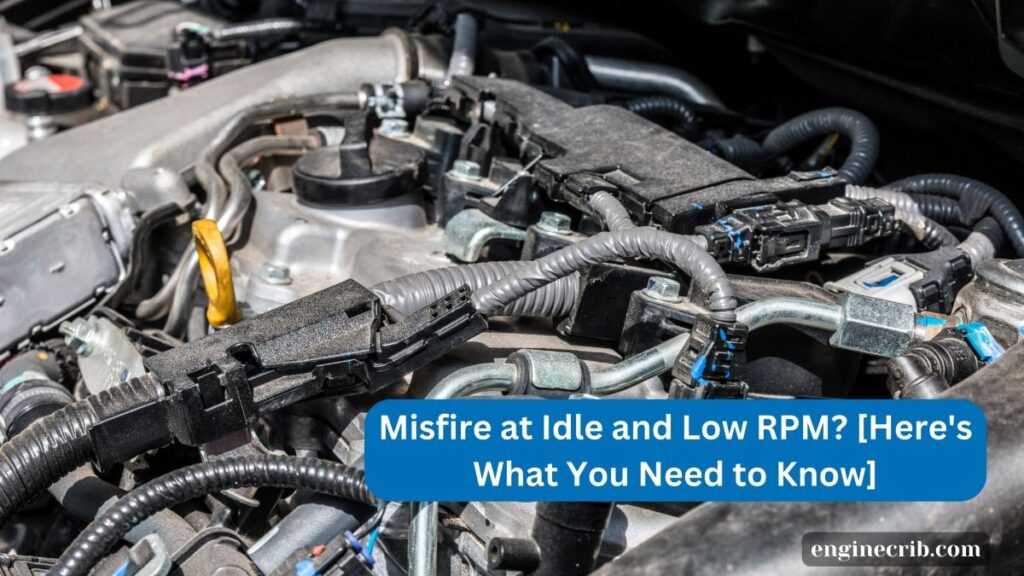Misfires can be annoying and sometimes dangerous if not rectified, as they can result in poor engine performance, decreased fuel efficiency, and even engine damage over time.
Fortunately, we can easily identify several frequent reasons for misfires and fix them with some basic understanding and troubleshooting procedures.
Therefore, if you’re having misfires at idle or low RPM, or simply want to learn more about this common engine problem, keep reading to understand what causes misfires, how to diagnose the problem, and how to fix it.

What Does Misfire at Idle and Low Rpm Mean?
A misfire at idle and low RPMs usually means that one or more cylinders in the engine are not firing correctly.
This causes the engine to stumble or lose rpm for a brief period before returning to average engine speed.
As your engine is idling, a misfire might occur, resulting in a harsh or uneven idle and this is a result of several factors.
What Causes Rough Idle At Idle and Low RPM?
1. Faulty Spark Plugs
When the spark plugs become blocked or damaged, it might result in a lack of gasoline inside the engine, resulting in rough idling at low RPM.
Spark plugs are responsible for supplying the spark that ignites the air/fuel mixture, resulting in the explosion that causes your engine to create power.
These plugs are crucial components of the engine; Therefore, when they fail, your engine suffers.
Signs of Bad Spark Plugs
- The engine would experience rough idle
- Trouble starting
- Engine misfiring
- Lack of acceleration
- Engine surging
- High fuel consumption
How to Fix?
Replace spark plugs with new ones. You can quickly get to a mechanic workshop and get these plugs.
2. Clogged Fuel Pump/ Filter
If your engine’s fuel pump or filter becomes clogged, it might cause rough idling because the engine runs out of fuel.
Your automobile will not start until the gasoline pump is working. This is because the pump transfers gasoline from the fuel tank into the engine. Therefore, if the pump fails, your car will not drive.
Fuel filters can become clogged as a result of material suctioned from the gas tank when you are low on gas/fuel.
Various things can impact the fuel pump, and when this happens, it limits the fuel supply to the engine, which may cause harsh idling. It’s not too expensive to replace the gasoline pump and filter.
Signs Of Clogged Fuel Pump/ Filter
- Low hum noise
- Lower Fuel Efficiency
- Car Surging
- Stalling at High Temperatures
How to Fix Clogged Fuel Pump/Filter
If your vehicle develops any of the symptoms listed above, or you believe your fuel pump is malfunctioning, get it checked by a professional technician to determine if the pump needs to be replaced.
3. Lean Fuel
A lean fuel mixture happens when your engine has too much air or not enough gasoline. This can cause your car’s engine to perform poorly. When not enough fuel is being burned, your automobile may stall, run rough, or struggle to accelerate.
In other words, when the air-to-fuel ratio contains less fuel than is required, the engine will misfire. This can occur due to a dirty gasoline filter, a faulty fuel pump, or a plugged fuel line.
P0171-P0172 codes may also appear on your dashboard. These codes will assist your mechanic in determining what type of repairs are required.
Symptoms of Lean Fuel
- Check engine light on
- Reduced acceleration
- The car won’t start
- Engine cutting out or stalling
- Poor fuel economy
- Increased Exhaust Emissions
4. Bad Fuel Injector
Fuel injectors are another component of the fuel delivery system, which transports fuel from the gas tank to the engine.
As a result, any problem with the fuel injectors can result in a gasoline shortage in the engine, which can also cause rough idling.
Signs of Bad Fuel Injector
- The check engine light illuminates the dashboard
- Engine misfire
- Fuel leaks, which would cause a fuel-like odor
- A significant drop in fuel economy
5. Low Compression
When compression is low, the automobile engine will begin to backfire. These problems typically occur when your car has a blown gasket, a broken valve, or leaking seals. Engine misfires can occur as a result of compression issues because the air-gas mixture fails to ignite.
Signs of Low Compression
- Misfiring and poor vehicle performance.
- A decrease in power output is a sign of worn-out internal parts.
How to Fix Low Compression
You need to first perform a compression test with a compression gauge. Ensure that you turn off the engine so it doesn’t start while you test the cylinders.
Remove the ignition coil and spark plug from the test cylinder. Insert and tighten the compression gauge extension.
Crank the engine and monitor the compression indicator until you achieve maximum compression. Each cylinder in a healthy engine should have 100 PSI.
A burst head gasket is a possible cause of low pressure in two adjacent cylinders.
If you do have low compression, the only way to fix it is to replace the leaking element, which might be the piston, piston ring, camshaft, head gasket, or valves.
Read: KYB Struts vs Monroe
Conclusion
Misfiring at idle and low rpm might occur due to filthy fuel injectors. Problems can arise since the fuel injector’s purpose is to distribute measured volumes of gas into the engine of the car.
Especially if dirt has clogged the fuel injector nozzles. They will not effectively distribute enough volumes of gas whenever this occurs.
Also, Ignition system components such as spark plugs can greatly contribute to engine misfires at idle and low rpm.
If you continue to drive your automobile in this state, the engine will ultimately backfire, fully stall, or die out.
This is why you must ensure to fix it as soon as possible. You can contact a professional technician to check these issues and help fix them.